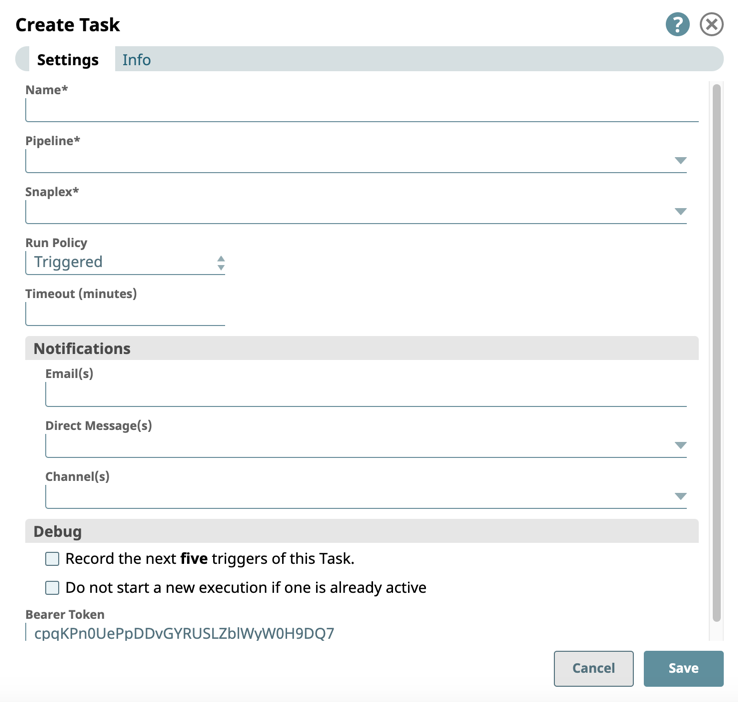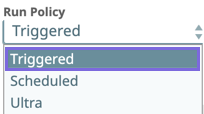In this Article
Overview
You can create an Triggered Task after you have created the Pipeline in SnapLogic Designer. You can create an Triggered Task in Designer or Manager. When you create an Triggered Task in Designer, the Pipeline is pre-selected when you open the Create Task dialog. When you create an Triggered Task in Manager, you must select a Pipeline to associate with the Task.
Creating a Triggered Task
- Choose one of the two following methods to create a URL from your Pipeline:
- In Designer, open the target Pipeline, and click the Task icon from the expanded Tool bar.
- In Manager, navigate to the target Project folder, click on the Add icon and from the drop-down list, select Task.
Alternatively, selecting Tasks from the Assets tab menu displays only those Tasks in the Project, and automatically displays the Create Task form when you click on the Assets toolbar.
- In Designer, open the target Pipeline, and click the Task icon from the expanded Tool bar.
- Once the Create Task dialog appears, fill out the form:
Name. Enter a name for the Triggered Task. This name is used in the URL when the Pipeline has unconnected inputs/outputs.
Unless otherwise noted, the names of any asset or project is limited to UTF-8 alphanumeric characters and these punctuation characters !"#$%&'()*+,-.:;<=>?@[\]^_`{|}~.
Pipeline. Select the Pipeline to run from the Pipeline drop-down menu. This Pipeline is triggered when the Triggered Task is called. If applicable, edit any of the parameter values from the Pipeline.
- Snaplex. Select the Snaplex on which to run the Pipeline from the Snaplex drop-down menu. The Snaplex must have a FeedMaster associated with it.
- If applicable, modify the Configuration Options in the dialog window, and click Save.
- To enable the Triggered Task, navigate in Manager to the project folder where the Triggered Task resides, and complete the following substeps.
- Click the Tasks tab in the asset toolbar menu.
- Select the target Triggered Task, and click Enable.
- You can run your Triggered Task through a variety of methods.
See Running Triggered Tasks for details.
Notifications
You can create email notifications based on the status of the Scheduled Task. If your Org supports Slack notifications, you can add Slack channels or recipients. To add recipients for Task notifications:
- In Notifications, enter each recipient's email address, separated by commas.
- If Slack notifications are configured for your Org, then the following fields support dropdown lists containing your Slack channels and users. For each field, you can also type to invoke suggested recipients in the field.
- Direct Message(s). Select Slack recipients from the dropdown list.
- Channels. Select Slack channels as recipients from the dropdown list.
- Select the status event for which Notifications are sent from the When Task has selector:
- Started. The Task is activated.
- Completed. The Task is completed.
- Failed. The associated Pipeline did not execute.
- Stopped. The associated Pipeline has stopped abruptly and the Task is no longer running.
- Suspended. Select if you want to receive a Notification if the Task is based on a Resumable Pipeline that is in a Suspended state.
Recipients receive notifications based on the selections in the When Task has field.
Viewing Ultra Task Details
After you create and enable your Ultra Task, you can view details about the Task.
- Open the Task Details page for your Ultra Task by clicking View Details:
- On the Task Details page, view Pipeline execution information for any instance by clicking Run Details.
- Navigate to the Dashboard Pipeline Wall to monitor the executions details about your Ultra Task.
Triggered Task Configuration Options
You can configure the following settings for your Triggered Task.
Bearer Token
You can user the auto-generated bearer token as the HTTP Authorization header. If you clear this field, then requests are authenticated by the Pipeline itself. You can also modify the field value as required.
Debug
You can set the following debugging options:
- Record the next five triggers of this task. Select to record five triggers of this Task after its creation.
- Do not start a new execution if one is already active. Select if you prefer to wait until the Task is complete before it can be re-triggered. This option lets you prevent a Pipeline from running again if a previous execution of that Pipeline is already running. If you attempt to call the Triggered Task when it is already running, you will receive a 409 error.
Timeouts
You can add Pipeline timeouts to Scheduled Task executions that occur frequently in a short period of time. To configure the maximum duration that a Pipeline is allowed to run, enter the number of minutes in the Timeout field. The Scheduled Task stops executing after the specified timeout duration is reached. The minimum timeout duration for a Pipeline is one minute. If you leave the field empty, the timeout is zero, which is equivalent to no timeout.
Change the Run Policy
When you create an Ultra Task, Triggered is the chosen Run Policy by default.
If you change the Run Policy setting to Ultra or Scheduled, the underlying Task type is modified. In such cases, you must re-configure the Task.






